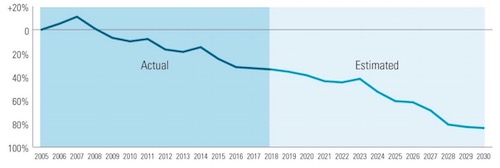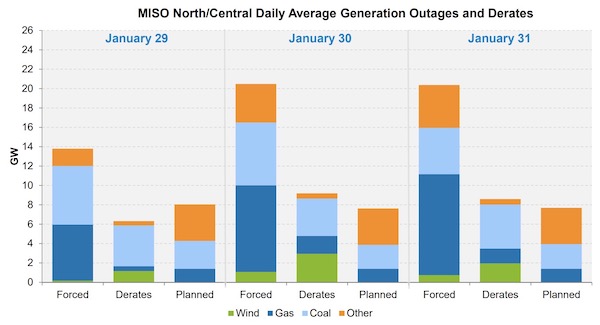
Xcel Energy plans to decrease emissions by 80% from 2005 levels by 2030. (Source: Upper Midwest Integrated Resource Plan for 2020-2034, 2019)
The 156-page report is comprehensive and thoughtful. Xcel did a lot of work on their own, plus hired a top-notch firm (E3) to do an independent analysis. Xcel collaborated with environmental organizations and community stakeholders over several years, and has been transparent about their planning methodology, adjusting it based on feedback. Their analysis combines advanced modeling of power plant performance and costs with real-world experience reflecting how systems perform in cold weather and on hot summer days. The report pays close attention to reliability, cost, and emissions reductions, as well as impact on local communities.
Xcel Energy proposes to retire all of its coal plants a decade early and to add considerable solar and wind energy. It will also ramp up energy efficiency and sources of flexible demand (e.g., electric air conditioners or water heaters that the utility can adjust when power is tight). They plan to extend one nuclear contract and increase gas production to supplement and complement the growth in grid renewables.

Xcel Energy looks to significantly grow wind, solar, and natural gas by 2034 while eliminating coal (Source: Upper Midwest Integrated Resource Plan for 2020-2034, 2019)
Impressive. But some are asking, can they do better? Over the last few weeks several organizations have filed comments on Xcel’s proposal, some of which are so substantive that they amount to independently-crafted proposals. Analysts hired by environmental organizations used the same modeling software as Xcel did, but adjusted some parameters. The reports claim to show that plans with no added gas can achieve similar or better reliability and cost.
One analysis by the Energy Futures Group, done on behalf of four environmental organizations, identifies a number of mistakes in the initial modeling, fixes those, and incorporates new information about model parameters that has become available since Xcel’s proposal was published in mid-2019. For example, they adjusted costs and lifetimes for renewables and batteries to updated standard values, incorporated a few renewable projects that Xcel has already approved, and added support for hybrid solar (solar plus battery). (1) Their analysis also assumes that somewhat longer duration storage (flow batteries) will be available in twenty years. With this, they found no need for additional natural gas, as shown in the “Clean Energy Plan” below.

One group of environmental organizations adapted the model that Xcel used to show that significant amounts of solar-plus-battery (“solar hybrid”), combined with small amounts of longer duration flow batteries can eliminate the need for additional gas (noted as “CT” and “Sherco CC”). (Source: A Clean Energy Future for Xcel by the Energy Futures Group, 2021)
The Sierra Club has also contributed a very in-depth analysis, again using the same modeling platform as Xcel used. They found and addressed many of the same issues as the Energy Futures Group report. Battery plant life estimates were too low, solar and wind costs too high, renewable plants constrained to be very large, solar-plus-battery projects were missing, improved wind technology was not reflected, and so on. They observed, as did the Energy Futures Group, that the new gas plant (“Sherco”) seems to have been hard-coded into all of the model runs. When they make it optional, it is not recommended by the modeling software since it seems to increase costs without increasing reliability. Their plan does not require additional gas resources.
The Sierra Club also looked closely at whether the contract with the Monticello nuclear plant needs to be extended, as proposed by Xcel Energy.
Xcel does not shy away from its commitment to nuclear energy, saying that nuclear is “an important system resource during the winter months, as it does not experience fuel supply issues and has a great track record during cold weather events.” They add that transmission constraints make nuclear necessary: “We simply could not maintain our system reliably, or affordably, given the massive renewable additions and corresponding transmission infrastructure that would be required to replace our Monticello nuclear plant, if it were even possible by 2030, given (our system’s) current transmission expansion issues.”
The Sierra Club report does not dismiss Xcel’s transmission concerns, but instead notes that small local renewable deployments, especially solar and batteries, can help address that concern. They say that “traditional resource planning tools neglect the significant reliability and diversity benefits of distributed generation”, and recommend tripling the amount of community solar and other distributed generation. They emphasize that these smaller plants create more local jobs and increase community investment when compared to utility-scale renewables, while also reducing pressure on the transmission grid.
The differences in the two plans are summarized in this chart below from the Sierra Club’s proposal.

The Sierra Club recommends significantly more hybrid solar, distributed solar, and battery storage, and no additional gas or extension of nuclear. (Source: Sierra Club submitted comments, 2021)
It is interesting, in light of the disaster in Texas, to understand what the proposals say about grid performance in cold weather, which can be extreme in the Upper Midwest. Xcel calls out two examples: the polar vortex of 2019 (January 28-30), and a more typical cold winter day (February 5). The graph below shows virtually no wind production during those times.

This chart shows fall-offs in renewables during the polar vortex of 2019 (see Jan 30) and during a more typical winter day (Feb 5). Source: Xcel Energy’s Reliability Appendix in this document.
Xcel is concerned about the duration of these events and the ability of batteries to handle them. For example, regarding February 5 they say: “Between 7:00 a.m. and 11:00 p.m., there were 16 consecutive hours where Net Load (load not handled by renewables) was over 5,400 MW. Due to the duration and magnitude of this shortfall, neither (flexible load) nor energy storage could substantially contribute to reducing the Net Load, at least for the entire period.” Substantial amounts of imported energy kept the lights on, though Xcel also requested that people turn down their thermostats. (2) Xcel’s resource plan says, with notable foresight, that the 2019 polar vortex, “although extreme, … may reasonably be expected to occur again”.
The Sierra Club, in response, points out that (as was the case in Texas) there were many resource outages during the polar vortex, with fossil plants affected as much as wind. While the wind outages were more of a surprise, the grid improved its winter wind forecasting immediately after this weather event by adding a temperature limit for wind turbines.

During the 2019 polar vortex, about 25% of capacity was offline, including fossil fuel and wind. (Source: MISO January 29-30 Maximum Generation Event Overview, 2019)
The Sierra Club mentions the possibility of weatherizing renewables (e.g., turbine insulation and heaters), but overall takes the stance that imports are the right solution here. “Power system planners, like all infrastructure engineers, do not design the system to be perfectly reliable during all conceivable events, as the cost of building such a system would be prohibitive and outweigh the benefits….The extreme temperatures necessary to cause generator failures will not affect a large geographic area simultaneously, and so any local drops in output can be addressed with imports from other parts of (our power market), or other regions.” They also suggest, with considerably less foresight than Xcel, that “this was an historic event, so such an extreme event is unlikely to be repeated for some time.”

The Upper Midwest’s power market, MISO, imported large amounts of energy from nearby PJM during the 2019 polar vortex. All markets from SPP east are part of the “Eastern Interconnection” with the exception of Texas’ ERCOT. (3)
So, what is the right answer for Xcel Energy and the Upper Midwest? Should they add more gas to their grid and extend the life of their nuclear plant in order to shore up variable renewables? Or should they double down on batteries, smart combinations of renewables (4), and imports to build an efficient, reliable, and even lower-emission grid? How do we evaluate the cost, reliability, and risk of different energy portfolios given so many unknowns? We have some good ideas about how technology, costs, and climate will evolve, but there are many gaps. We have to make our best guesses and create a plan that can flex as we learn more. Do we continue to invest in fossil fuel infrastructure, as Xcel recommends, or place a bigger bet on evolving technology and lean into the future with a cleaner ambition? This is a very interesting and important discussion.
Notes and References
0. An article from Inside Climate News inspired me to look at these resource plans for the Upper Midwest.
1. Xcel had largely disabled that option due to concerns about how long the modeling program would take to run.
2. Xcel says: “The level of these resources that MISO had to use to remain operational and avoid further emergency actions ranged from 5,000 MW to 11,500 MW – with an average of 6,500 MW on January 30th. The maximum offered reserve resources was 13,500 MW, which MISO nearly exhausted at one point in order to avoid a critical deficiency in available energy.” (MISO stands for Midcontinent Independent System Operator, and is the power market for the Upper Midwest, just as CAISO is the power market for our area.)
3. Texas is an island when it comes to electricity. This can hurt reliability and cost.

Source: ERCOT
4. The Sierra Club proposal has an interesting section detailing how combinations of renewables mutually amplify one another. See pages 66-67 (pdf pages 71-72) of their analysis.
Current Climate Data (January 2021)
Global impacts, US impacts, CO2 metric, Climate dashboard (updated annually)
Comment Guidelines
I hope that your contributions will be an important part of this blog. To keep the discussion productive, please adhere to these guidelines or your comment may be moderated:
- Avoid disrespectful, disparaging, snide, angry, or ad hominem comments.
- Stay fact-based and refer to reputable sources.
- Stay on topic.
- In general, maintain this as a welcoming space for all readers.




